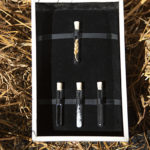Hubert Maga (perruque MAVA-musée d'art de la vie active)
2010 - Sculpture (Sculpture)
60 x 50 x 23 cm
Meschac Gaba
The headdresses, woven from artificial hair braids, symbolize historical icons including Martin Luther King, Kwame Nkrumah, Fela Kuti and King Guézo of Dahomey. The wigs portraying these grand figures also unambiguously recall Africa to mind. By declaring Cotonou, one of Benin’s cities, the Art Museum of Real Life, and by having thirty white-clad figures wearing Gaba’s latest series of tresses cross through it, he draws attention to the urban space and its inhabitants’ strategies of survival and improvisation. In doing this, he enquires into alternative models, and into the tasks and local interpretations of the museum: “The micro-macro economy represents the survival of the inhabitants of this city day after day (…) In the city of Cotonou, you can see installations everywhere – it is like an open-air museum.” In this series Meschac Gaba weaves symbolic crowns that suggest a historical character, suggested through one of her or his realizations. Here in the case of former Beninese president Hubert Maga, the hairstyle headdress is woven in the form of a hospital that was built during his reign and was named after him. The forms and styles of braided hairstyles range from purely functional to complex and symbolic: hair can be an indicator of age, authority, social status, religion or even supernatural powers. In cities across Europe and the Americas, African hair braiders produce extravagant creations based on their traditional braiding skills and styles, uniting capitalist commerce with traditional culture. In Gaba´s work, two seemingly divergent products of humankind, hair and architecture, meet as equally significant symbols of modern culture. In making this work, Gaba assumes the role of the nouveau tresseur or tresseuse (the new braider), a traditional Beninese hair braider, reassigning meaning to architectural forms and cultural experiences.
born in 1961 in Cotonou, Benin. He lives and works between Cotonou and Rotterdam Over the past 20 years, through various bodies of works, Beninese artist Meshac Gaba has attempted to reframe contemporary African artistic identity, asking us to shed our preconceived ideas and re-imagine the African continent with a more valid contemporary image. Meschac Gaba emerged onto the international contemporary art scene in 1999 when he presented the Museum of Contemporary African Art in the exhibition “Mirror’s Edge” at Bilmuseet in Umea, Sweden. It marked the beginning of an expansive conceptual and virtual project based on the subjectivity of museum spaces. Twelve installations constitute his imagined Museum of Contemporary African Art (MCAA), originally created in 1997 and shown individually at other international institutions or events since then. Confronted with one’s cultural centrality, the spectator is asked to reconsider his viewpoint of memory and history. Gaba’s complex and varied artistic practice provides an in-depth examination of cultural appropriation, public space, the role of the western museum, and the changing global economy. His appropriation of tourist imagery –from cinema and souvenirs to magazines and museums– allows the viewer to deconstruct the western iconography and disturb modes of representation in contemporary art.
Colors:
Related works sharing similar palette

© » KADIST
Curtis Talwst Santiago
2017Curtis Talwst Santiago has been creating intimate and performative environments within these small spaces for several years; the artist used to carry them around to show visitors one on one, opening up a scene in the space of his hand...

© » ARTS EQUATOR
Migrant Ecologies Project: A Grain of Wheat Inside a Salt Water Crocodile | ArtsEquator Thinking and Talking about Arts and Culture in Southeast Asia Grain of Wheat July 8, 2019 A biscuit tin formerly containing Mermaid Brand Cream Crackers with wheat designs on the outside was chosen as the box to house the wheat as well as test tubes of salt, needles and Singapore’s very own NEWater – all for the wheat’s ritual protection...

© » GALERIA FOKSAL
Dominika Olszowy, Vesuvius eruption victim’s brain turned to glass - Galeria Foksal Polski English GALERIA FOKSAL #Las Rzeczy Exhibitions Artists About gallery Contact Dominika Olszowy Dominika Olszowy, Vesuvius eruption victim’s brain turned to glass September 23, 2022 Exhibition opening: September 23rd from 6 pm Exhibition duration: September 23rd – November 2nd, 2022...

© » KADIST
Ntshepe Tsekere Bopape (aka Mo Laudi), Mobilis Alkebulan, performance, KADIST, Paris, 2021 What is the role of the artist if it’s not to make the revolution irresistible, to make hearts and minds vibrate to a higher frequency? Music, as sound, knows no borders; it is a form that crosses invisible borders created by humans to separate races, classes, cultures, sexes...

© » SLASH PARIS
Chambre à brouillard — Juliette Agnel, Clément Bagot, Nicolas Darrot, Youcef Korichi, Alyssa Verbizh, Anne-Charlotte Yver — L’ahah Griset — Exhibition — Slash Paris Login Newsletter Twitter Facebook Chambre à brouillard — Juliette Agnel, Clément Bagot, Nicolas Darrot, Youcef Korichi, Alyssa Verbizh, Anne-Charlotte Yver — L’ahah Griset — Exhibition — Slash Paris English Français Home Events Artists Venues Magazine Videos Back Chambre à brouillard — Juliette Agnel, Clément Bagot, Nicolas Darrot, Youcef Korichi, Alyssa Verbizh, Anne-Charlotte Yver Exhibition Drawing, publishing, film, installation.....

© » KADIST
Yosuke Takeda
2014Yosuke Takeda gives the viewer brightly colored views, each of which he has searched out and patiently waited for...

© » KADIST
Abraham Oghobase
2018This series of photographs is inspired by the artist’s travels to Jos, Nigeria...

© » KADIST
Alexis Smith
1990Iron Sorrows (1990) brings together what are for Alexis Smith common motifs and materials such as scavenged and repurposed metal, and street signage...

© » SLASH PARIS
Chambre à brouillard — Juliette Agnel, Clément Bagot, Nicolas Darrot, Youcef Korichi, Alyssa Verbizh, Anne-Charlotte Yver — L’ahah Griset — Exposition — Slash Paris Connexion Newsletter Twitter Facebook Chambre à brouillard — Juliette Agnel, Clément Bagot, Nicolas Darrot, Youcef Korichi, Alyssa Verbizh, Anne-Charlotte Yver — L’ahah Griset — Exposition — Slash Paris Français English Accueil Événements Artistes Lieux Magazine Vidéos Retour Chambre à brouillard — Juliette Agnel, Clément Bagot, Nicolas Darrot, Youcef Korichi, Alyssa Verbizh, Anne-Charlotte Yver Exposition Dessin, edition, film, installations.....

© » KADIST
Raphaël Zarka
2001This photograph seems to be awaiting meaning, it more or less evokes known elements without really identifying with them completely: a motorway interchange, a bridge, an electric pylon… In fact this is the end of the tracks of the Aérotrain, a wheelless monorail invented by Jean Bertin in the 1970s, which acts like ‘a fossil of movement on landscape scale’, as explained by the artist...










